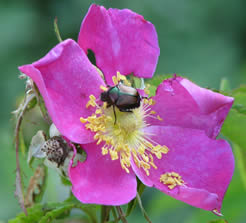|
You can help reduce sewage flowing into Onondaga Creek
 Many people aren't aware that the creek flows through downtown Syracuse
and could be an asset to our community. Many people aren't aware that the creek flows through downtown Syracuse
and could be an asset to our community.
Near
South Ave. during a creek cleanup project.
But when there's a storm, sewage actually flows into our creek! Those who have canoed down the creek can give you first-hand info. (Talk to John Allen about this.) There's nothing like toilet paper (post-use) festooning the banks of our creek...
But things are changing. Onondaga County has dropped the very expensive plans for a new sewage treatment facility (i.e. gray infrastructure) and is now creating green infrastructure. You can be part of this solution simply by keeping the water that falls on your property on your property so stormwater doesn't run off into the sewer and then into our waterways.
One very effective, beautiful, and habitat-friendly way to do this is to create a rain garden. This Post-Standard article describes one such local project.
A rain garden is simply a sunken garden designed to absorb rainwater from impervious areas
such as roofs, driveways, walkways, and compacted lawn areas. Rain
gardens reduce runoff by allowing stormwater to soak into the ground,
as opposed to flowing into storm drains and surface waters, which can
cause erosion, water pollution, flooding, and diminished groundwater.
Native plants are perfect for rain gardens! Plants suitable for rain gardens in the Northeast are provided online by Brooklyn Botanic Garden, and in hard copy by Onondaga County Cooperative Extension.
Rain Gardens: A How-To Manual for Homeowners provides more in-depth information to help you create your own beautiful contribution to solving a community problem. |
|
Butterflies down; Japanese beetles up
 You've planted lots of larval host plants (food plants for the caterpillar phase of a butterfly's life) and lots of nectar plants. You have a sunny location away from the wind. You've done your part, now where are they? You've planted lots of larval host plants (food plants for the caterpillar phase of a butterfly's life) and lots of nectar plants. You have a sunny location away from the wind. You've done your part, now where are they?
Unfortunately, our weather this summer--cool and rainy--doesn't favor butterflies. There have been noticeably fewer butterflies and skippers than in summers past. But you've now got the larval host plants and nectar plants (if they're perennials), so you'll be all set for a better butterfly experience next summer.
On the other hand...
Japanese beetles are thriving. Here's some info on natural Japanese Beetle control based on an article at www.life123.com:
Five organic ways to get rid of Japanese beetles
Avoid growing their favorite plants, which in our gardens include native roses, sundrops, and raspberries. But this "solution" seems counterproductive. We want these plants!
-
If you see them on your plants, pull them off and kill them. As far
as Japanese beetles are concerned, the more the merrier; the more you
already have, the more you'll get. -
Don't use pheromone traps (those plastic bags that get full of beetles while attracting legions more than they catch). They were initially designed to sample beetle populations, not to control them.
-
Use biological control agents such as nematodes and milky spore bacteria. - Keep your produce harvested. Overripe and rotting produce attracts beetles.
Removing by hand really is effective!
According to
the University of Kentucky Cooperative Extension Service, when you remove beetles
daily by hand from a plant, only about half as many are attracted to
that plant compared to those on which beetles are allowed to
accumulate.
Japanese beetles tend to congregate in clusters that can
easily be knocked off of your beloved plants into a bucket of soapy
water where they will drown. You may initially be squeamish, but after a while, you'll probably find it doesn't bother you at all! This is most easily done in the early morning while they are still sluggish. (Squishing them is also an option.)
In our experience, early, consistent efforts using the soapy water method pays off!
|
|
Looking for a garden vacation destination?
The New England Wildflower Society's Garden in the Woods is "... an eye-popping showcase for our native plants . . . there can be few more beautiful places on the planet." ~ Boston Globe
The Garden has more than 1,000 native plant species, featuring more than 150 rare
and endangered native plant species. Located 20 miles west of Boston,
the Garden displays an ever-changing tapestry of flowers and foliage. You can buy native plants at the store on the grounds of the Garden.
Later in the season, you can visit Nasami Farm and Sanctuary in western Massachusetts. This native plant nursery, owned by New England
Wild Flower Society, reopens to the public for its fall season September
3 through October 4, Thursdays through Sundays 10 a.m. to 5 p.m.
Or take a "staycation"
If you have a habitat garden, staying home--a "staycation"-- can be just as interesting and probably more restful than traveling. The key is to clear your calendar of other activities, tell people you're on vacation (but don't tell them your vacation will be at home), and don't do any chores. Just enjoy your time relaxing in your habitat garden.
|